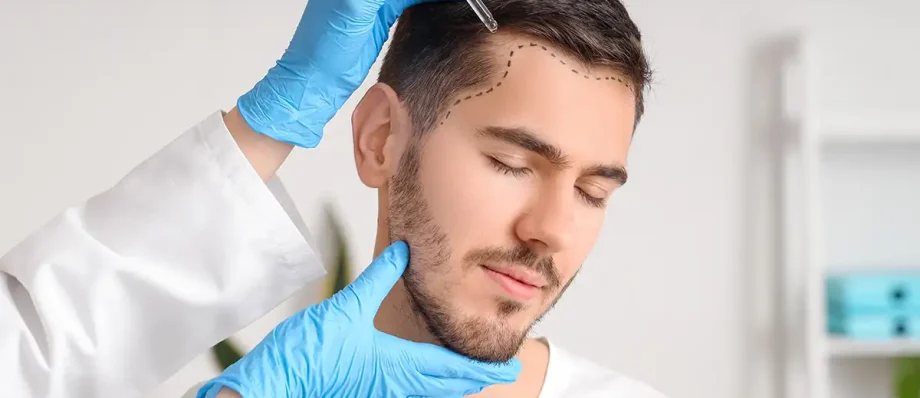Hair Transplant Repair
What Is Hair Transplant Repair?
Hair transplants can be life-changing, but what happens when they don’t go as planned? Enter the realm of hair transplant repair—a procedure that aims to correct earlier transplants that have resulted in unsatisfactory outcomes. Whether due to unnatural hairlines, visible scarring, or uneven growth, hair transplant repair looks to rectify these issues, enhancing both the appearance and the confidence of the recipient.
Is It Possible to Reverse a Hair Transplant?
Yes, it is possible to reverse a hair transplant to some extent, but the procedure is complex and may not totally restore the earlier appearance. So, you should be patient. Reversing a hair transplant usually entails removing the implanted hair grafts. This approach can help resolve undesirable outcomes or fix locations that appear unnatural.
However, there may be some scarring where the grafts were first implanted and removed. FUE is a common technique used to reduce scarring during this procedure. Patients seeking reversal should speak with a competent hair restoration doctor to discuss the best options and potential outcomes for their specific circumstance.
Why Do Most Hair Transplants Fail?
Hair transplant surgeries have become increasingly popular as a solution for hair loss, offering hope to those looking to restore their hairline and improve their self-confidence. Despite the advances in technology and techniques, not all hair transplants result in the lush, natural-looking hair that patients hope for. Understanding why hair transplants fail can help prospective patients make informed decisions and set realistic expectations.
One of the primary reasons for hair transplant failures is the choice of surgeon. Hair transplant is a delicate procedure that requires precise skill, experience, and artistic insight. Unfortunately, not all doctors performing these surgeries are adequately trained or experienced. Choosing a surgeon who lacks the necessary ability can lead to poor placement of hair follicles, unnatural-looking results, and even significant scarring.
Successful hair transplants rely heavily on the quality and quantity of donor hair available. If the donor area does not have enough healthy hair follicles, the transplant might not cover the balding areas effectively.
Similarly, if the hair quality is poor—thin, weak, or brittle—the results might not meet expectations. This can lead to patchy or visibly thin outcomes, which are often considered failures.
The success of a hair transplant also hinges on how the hair follicles are managed during the procedure. Follicles can be damaged due to rough handling, prolonged exposure outside the body, or improper storage conditions. Such damage can lead to poor graft survival, meaning that the transplanted hair does not grow as expected, leading to sparse or uneven results.
Post-operative care is crucial for the success of a hair transplant. This includes following strict guidelines on washing, avoiding certain activities, and using medications. Non-compliance with these post-operative instructions can jeopardize the healing process and affect the growth of the transplanted hair. Additionally, lifestyle factors such as smoking or poor diet can impair wound healing and hair follicle health.
Some patients may have underlying health conditions that affect hair growth, such as autoimmune diseases or hormonal imbalances. These conditions can interfere with the success of a hair transplant, as they might continue to cause hair loss even after the surgery.
Hair Transplant Repair in Turkey
When your first hair transplant doesn’t unfold as you dreamed, Turkey stands as a beacon of hope and expertise in hair transplant repair. Known globally for its cutting-edge medical facilities and leading hair restoration specialists, hair transplant in Turkey offers a unique blend of advanced techniques and affordability that attracts patients from around the world.
Hair transplant in Istanbul, Ankara, and Izmir, clinics are equipped with ultramodern technology to correct earlier hair transplant failures. Whether it’s addressing unnatural hairlines, patchy results, or visible scarring, Turkey’s skilled surgeons employ meticulous techniques to enhance and rectify earlier outcomes.
Don’t settle for a hair transplant that doesn’t reflect your true self. Turkey’s blend of advanced techniques, experienced surgeons, and cost-effective solutions makes it the ideal place to turn your past disappointment into a future of confidence and satisfaction.
What Leads to Hair Transplant Repair?
Hair transplant repair is necessary when the first procedure doesn’t meet the expected standards. Common issues include:
Unnatural Appearance: The hairline may look too straight, artificial, or not in harmony with the natural hair growth pattern.
Poor Density and Coverage: Sometimes, the transplanted area may have uneven density, making it look patchy.
Scarring: Visible scars from the donor or recipient sites can be aesthetically displeasing.
Old Techniques: Older methods like punch grafts often left more noticeable scarring and less natural-looking results.
Techniques Used in Hair Transplant Repair
Repair techniques have evolved, using advanced technologies and refined methodologies. Some of the most effective techniques include:
FUE : This method involves removing individual hair follicles from the donor area and re-implanting them into the scarred or poorly transplanted areas. FUE is beneficial for reducing scarring and improving the overall look of the hair transplant.
FUT : Also known as the strip method, FUT can be used for larger areas. It involves taking a strip of hair from the donor area, which is then dissected into individual follicular units before transplant.
Scalp Micropigmentation (SMP) : This technique involves tattooing tiny dots that mimic the appearance of a shaved head. It is useful for disguising scars or increasing the visual density of hair.
Camouflage Techniques: Sometimes, small grafts are used to create a more natural-looking hairline, or existing grafts are redistributed to fill in gaps more effectively.
Consultation is the first and important step in the repair process. During this phase, a skilled surgeon assesses the extent of the issue and devises a strategy tailored to the patient’s needs. The goal is to ensure that the results look natural and harmonious with the patient’s facial features and hair characteristics.
The procedure itself follows the principles of the first hair transplant but with a focus on rectifying earlier mistakes. This may involve removing some of the old grafts, redistributing them, or adding new ones. Diligence is paramount to create a natural hairline and satisfactory density.
After hair transplant repair, the care regimen largely mirrors that of a standard transplant. Patients may experience some swelling, redness, and discomfort, which usually subside within a few days. The transplanted hair will fall out—a normal part of the process—before growing back permanently after a few months.
The final results of hair transplant repair can significantly boost a person’s self-esteem and satisfaction with their appearance. However, setting realistic expectations is important. While tremendous improvements are achievable, perfection is not always possible.
Hair transplant repair is a hope for those dissatisfied with their earlier hair restoration results. With the right approach and skilled execution, it can effectively enhance the cosmetic appearance and emotional well-being of patients. If you are considering this procedure, you should choose a surgeon with experience in hair transplant repairs to ensure the best outcome.
Hair Transplant Repair Cost in Turkey
Turkey has appeared as a top country for hair transplant surgeries, including repair procedures for less-than-satisfactory results from earlier treatments. Known for combining high-quality medical services with affordability, hair transplant cost in Turkey offers an appealing choice for those looking to fix issues like unnatural hairlines, visible scarring, or uneven hair growth.
What to Consider Before Hair Transplant Repair in Turkey
Before deciding on a hair transplant repair in Turkey, you should research thoroughly. Look for clinics with good reviews and check the credentials and portfolio of the surgeons. It is also wise to have a detailed consultation, possibly via video call, to discuss your specific needs and expectations. Additionally, consider the travel costs and accommodation, as these will add to your overall expenses.


